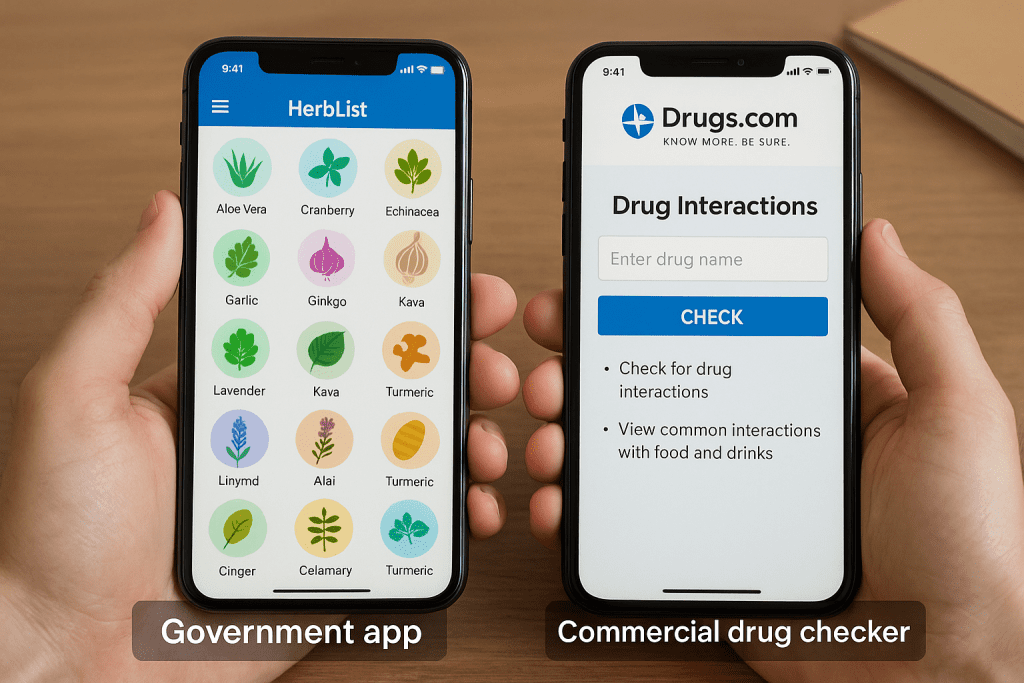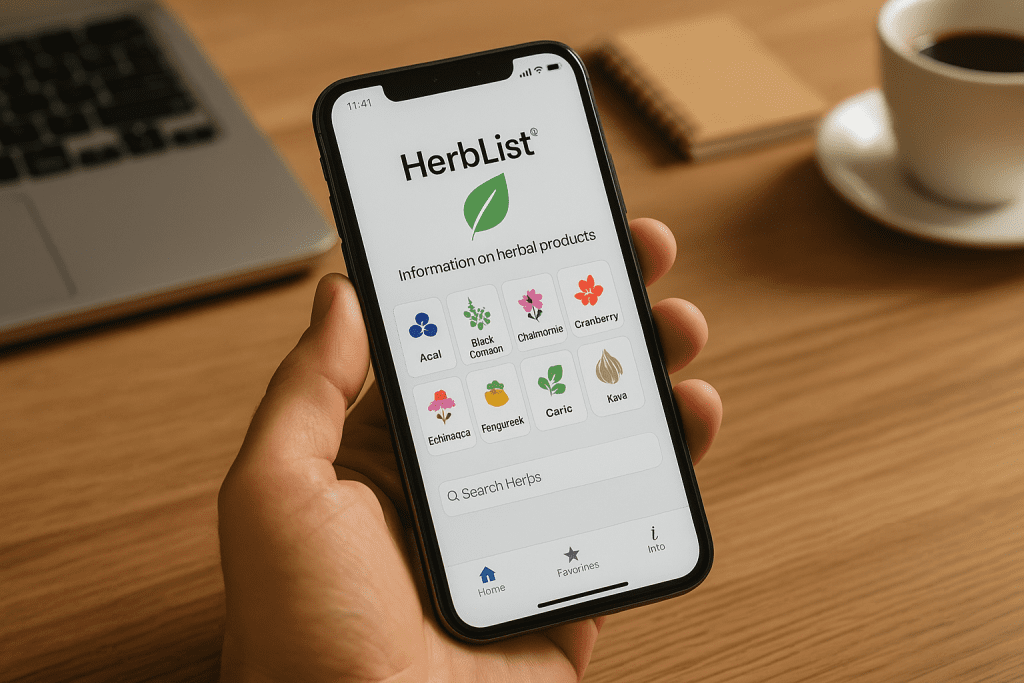Looking for a free NIH supplement drug checker backed by research and free of commercial influence? This article explains what government-sponsored health tools like HerbList and the NIH Drug Information Portal offer, how they work, and how they compare to commercial apps.
While some features have been discontinued, these tools still provide reliable data on herbal and drug interactions, if you know where to look.
Let’s explore the current NIH options, their strengths, and where they fall short compared to apps like Drugs.com or Medscape.
Summary / Quick Answer
If you’re seeking a free NIH supplement drug checker, here’s what’s currently available:
- HerbList App: A mobile tool for evidence-based herbal supplement safety and interactions
- NIH Drug Information Portal: Web access to over 15,000 drug records and related databases
- RxNav (Discontinued): NIH’s former drug interaction API, terminated in 2024
Pros:
- Free and ad-free
- Based on scientific literature
- Available on iOS and Android
Cons:
- HerbList covers ~50 herbs only
- No comprehensive drug-drug interaction checker now
- Limited integration with clinical tools
Use HerbList for herbal supplement research, and combine it with trusted commercial apps for full interaction checking.

NIH’s Free Interaction Tools: What Still Exists (and What Doesn’t)
NIH provides public access to tools designed to help consumers and healthcare professionals understand supplement and drug interactions. But there’s a catch: recent changes have narrowed their scope.
HerbList App: Focused but Reliable
HerbList, developed by the National Center for Complementary and Integrative Health (NCCIH), is a free NIH app that offers detailed, research-based summaries on more than 50 commonly used herbs. It’s available for iOS and Android and designed for laypeople and professionals alike.
Key features:
- Searchable database of popular herbs (e.g., turmeric, kava, ginkgo)
- Safety notes and potential herb-drug interactions
- Offline access and bookmarking
- No ads, no sales agenda
It draws directly from NCCIH’s Herbs at a Glance content, offering science-backed summaries on side effects, benefits, and usage risks. For instance, if you’re wondering whether St. John’s Wort might worsen insomnia when used with SSRIs, HerbList gives a concise, research-driven explanation.
NIH Drug Information Portal: Broad but General
Unlike HerbList, the NIH Drug Information Portal covers a wider spectrum of over 15,000 drugs. Managed by the National Library of Medicine (NLM), it connects users with data from trusted sources like PubMed, AIDSinfo, and DailyMed.
You can search for a drug name and access:
- Chemical properties
- Pharmacological actions
- Clinical trials and consumer health resources
However, it doesn’t provide real-time interaction checking, especially not across multiple drugs or supplements. It’s best used as a reference tool rather than a prescriber’s assistant.
| Tool | Best For | Key Limitation |
|---|---|---|
| HerbList | Herb-drug safety checks | Covers only ~50 herbs |
| Drug Info Portal | Drug reference lookups | No interaction checker |
Why RxNav’s Discontinuation Matters
Until recently, NIH also maintained RxNav, a developer-facing API tool that offered drug-drug interaction checks. It was popular among clinicians and app developers due to its integration with DrugBank and ONCHigh datasets.
But as of January 2, 2024, the NIH officially shut down RxNav’s interaction API, citing data maintenance and funding concerns.
Previously, RxNav could:
- Analyze multiple drugs simultaneously
- Identify potential QT prolongation risks via ONCHigh
- Connect with DrugBank for additional insights
Its removal left a noticeable gap, especially for platforms or health apps seeking government-verified sources.
Now, those looking for high-quality interaction databases often turn to commercial or academic tools like:
- DDInter (Open-source with 240K interactions)
- Drugs.com, Medscape, or WebMD for consumer-friendly interfaces
Commercial Apps vs. NIH Tools: What You Gain and What You Miss

What Commercial Apps Offer
Paid and ad-supported interaction checkers like Drugs.com, Medscape, and Lexicomp provide:
- Real-time alerts
- Drug-food, drug-condition, and drug-herb interaction scanning
- Severity ratings and clinical recommendations
- Integration with electronic health records (EHRs)
For instance, if a patient’s anxiety spikes while using SAM-e alongside an MAOI, Medscape or Lexicomp can provide both a warning and guidance for alternative therapies.
NIH’s Advantages
Despite their limitations, NIH tools remain:
- Free
- Commercially unbiased
- Based on peer-reviewed research
They’re perfect for herbal supplement users who want accurate information without being pushed toward a brand or product.
Limitations to Note
| Feature | NIH Tools | Commercial Apps |
|---|---|---|
| Herb coverage | ~50 herbs | Thousands |
| Interaction checking | Herb-only (limited) | Full interactions |
| Evidence transparency | High | Variable |
| Ads or upsells | None | Often present |
The Evidence Challenge: Why Herb-Drug Interactions Remain Under-Studied
The truth? Most herb-drug interactions are still poorly understood.
NIH resources, including HerbList and the Clinical Digest on Herb-Drug Interactions, often emphasize that current warnings are based on:
- Case reports
- Animal studies
- Pharmacological theory
Only a few combinations – such as St. John’s Wort with SSRIs or ginkgo with anticoagulants – have solid clinical backing.
Even top-tier databases must make educated guesses. That’s why a hybrid strategy—starting with the NIH and cross-referencing with commercial tools—often yields the best clinical outcomes.
Using NIH Resources Effectively (and Safely)
Think of NIH’s tools as your first checkpoint, not the final word.

How to Use HerbList:
- Download from the Apple App Store or Google Play
- Search by herb name
- Read about side effects, potential interactions, and usage tips
- Bookmark herbs for future reference
For deeper dives:
- Use MedlinePlus Drug & Supplement Info
- Look up structured clinical trial data via PubMed
- Cross-reference any findings with tools like Drugs.com
Always consult a pharmacist or physician when managing complex medication regimens.
Conclusion
NIH’s current supplement and drug interaction tools—primarily HerbList and the Drug Information Portal—offer a reliable, cost-free way to research herbal supplements and basic drug data. However, the shutdown of RxNav means users now need to combine these government-sponsored health tools with more robust commercial platforms to stay fully informed.
For casual users and supplement consumers, starting with NIH apps ensures evidence-based, ad-free information. For more comprehensive interaction management—especially involving multiple drugs—platforms like Medscape or DDInter may be necessary.
Looking for related information? Check out:
